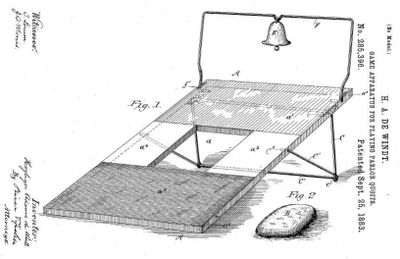Busting The Myths
There are many stories circulating about the origin of cornhole. Some say that it was invented by a 19th Century Kentucky farmer. Others claim that Plains Indians in Illinois were responsible. Still others point to the Amish as being the original creators. The fact is, none of the above are true!
In 1883, Hayliger Adams De Windt, a native of New York state, was granted a U.S. patent for the game shown in the drawing at the right, which he called "parlor quoits". De Windt was a Harvard graduate and the great grandson of President John Adams' youngest daughter.
It's interesting to note that, contrary to popular belief, the idea of tossing bags into holes competitively sprang from New England aristocracy - not from the Ohio Valley or the mountains of Kentucky, as many believe.

Within only a year or so after De Windt's patent was issued, a Massachusetts toy manufacturer, Morton Converse @ Co., began producing a similar game known as Faba Baga.(Latin for bean bag) It is unclear whether or not De Windt and the Morton Converse Co. were associated in any way, but one thing IS clear and has been documented in many newspaper clippings from that era - Bagtoss, or "the bean bag game", as it was referred to then, became immensely popular by the mid 1880's, and it remained popular for decades thereafter. At some unknown point, the early versions of the game gave way to what we recognize now as modern cornhole. This is where the history of cornhole board evolution gets a little muddy.

In 1974, an article appeared in the September issue of Popular Mechanics magazine which contained instructions about how to build a bean bag game. This is believed to be the first widely published picture of what a modern cornhole set was supposed to look like. It measures 36" X 24" - a foot shorter than a regulation set. The hole is located 8" down on center from the back edge of the board instead of the current 9".(possibly a mistake by the author)
The 3' X 2' version of the game has been very popular in the Chicago area for some time. Is this where modern era cornhole began to emerge? In the cornhole industry, these sets have become known as "tailgaters" because their smaller size makes them easier to transport to events where tailgating is popular, but 2' X 4' sets are the preferred size for much of the rest of the nation today.
If you would like to read more about bagtoss history, click the link below. What we've posted here is a brief summation of what appears in that article. We thought we would try to contribute to help set the record straight, to the degree it's possible.
https://esnpc.blogspot.com/2016/08/parlor-quoits-bean-bags-and-faba-baga.html
c. 2019 delawarecornhole.com
